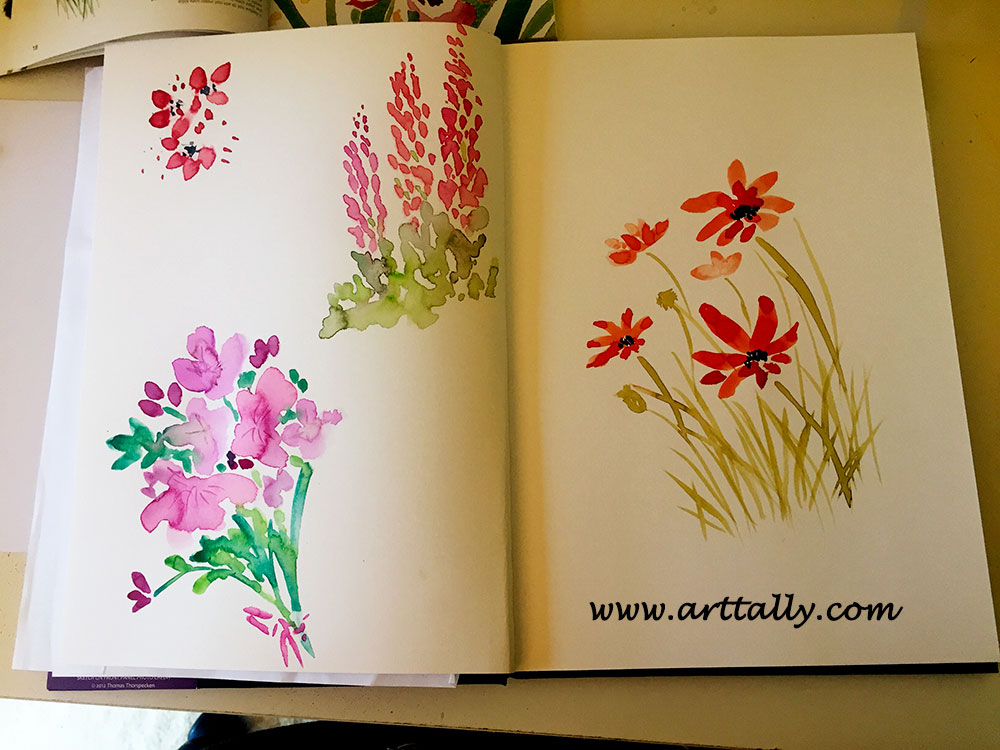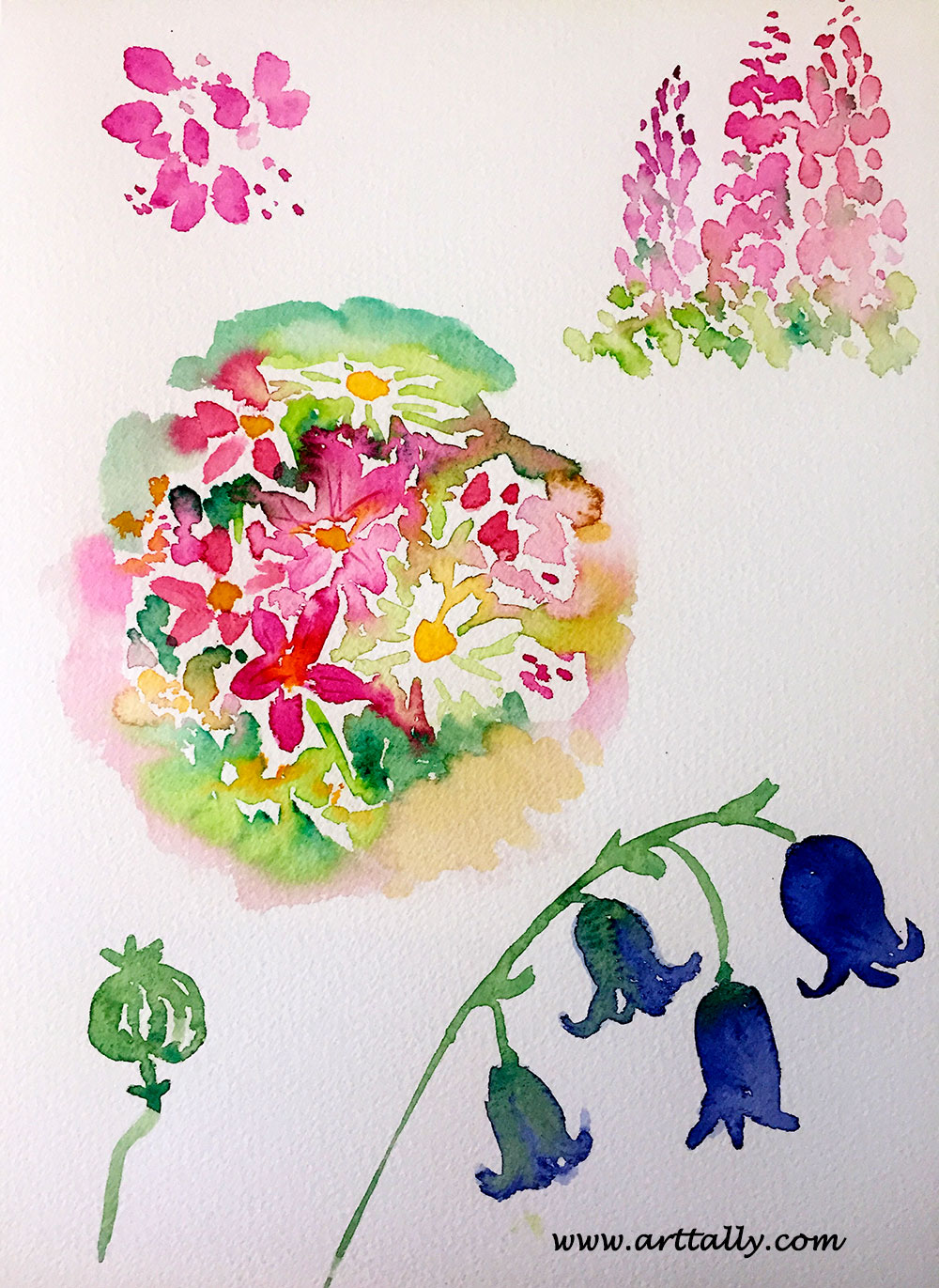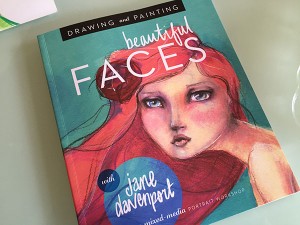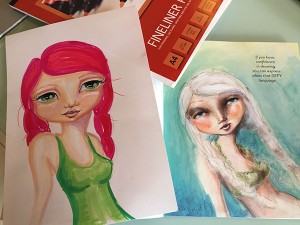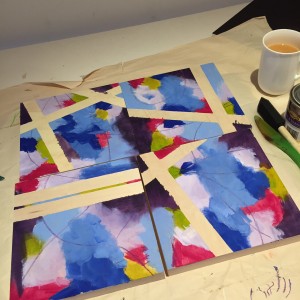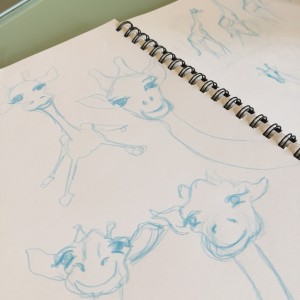30 minute flowers - the final 4 paintings
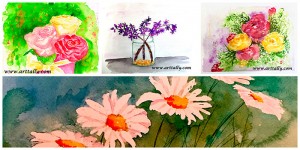 I do love painting flowers, especially in watercolour. But I have to say that I am quite pleased at the prospect of painting something else next month.
I do love painting flowers, especially in watercolour. But I have to say that I am quite pleased at the prospect of painting something else next month.
These are the final four paintings for the month. The daisies are from Fiona Peart's book that inspired this whole series of 30 minute flowers . The others utilise some of the techniques that she uses but are simply from references that spoke to me.
If you would like to see the whole series together, head over here!
30 minute flowers no 6
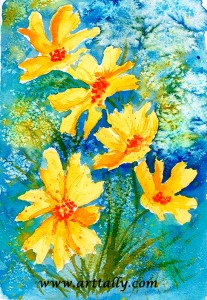 Sometimes painting the watercolour background can be even more fun than painting the subject itself.
Sometimes painting the watercolour background can be even more fun than painting the subject itself.
Number 6 in this series of 30 minute flowers uses salt to create some lovely texture behind the blossoms.
If you are playing along at home, it is from page 48 of Fiona Peart's book Painting Flowers in Watercolour!
Painting flowers in Watercolour with Fiona Peart
Painting Flowers in Watercolour with Fiona Peart
I have a rather lovely little book called Painting Flowers in Watercolour, by Fiona Peart. It is a part of the 30 Minute Artist series. Since I love flowers and am terribly impatient it only makes sense for this month's series to be 30 Minute Flowers.
The first steps in the book are about getting to know your materials and your palette. An early exercise was to do this by making a big splashy page of puddles of colour... you don't have to ask me twice!
30-minute-flowers-journal-page-no-1-w_arttally
Then we start painting flowers with watercolour by using easy brush marks and lots of negative painting to create simple shapes.
I have a Stillman and Birn Journal which is just divine. It is a hardbound journal and the paper is 270gsm. However, I had a bit of thing for hot press paper when I purchased it because I do love drawing on the silky surface with ink and coloured pencil etc. I used hot press paper for my Flower Face series and loved it. For a clean illustration the smooth surface is lovely. But if you want to use watercolour in a more traditional painterly way, the cold press surface is far more forgiving. So obviously now I want to trot off and buy a cold press Stillman and Birn journal....
30-minute-journal-page-on-cold-press-w_arttally
I repeated some of the paintings from the journal using cold press paper - not sure you can see the difference in the photos. The cold press paper handles more water, so I seem to have more cauliflowers appearing with smooth (hot press) paper than I do with the more textured cold press paper.
Using cold press paper, I had a go at Fiona's painting, Orchid (page 19 if you are following along in the book!). It's a bit different from the flowers I painted in my Watercolour Flowers series because there was no pencil drawing to begin with (eek - brave!)
Fiona advises building the painting up looking at the shapes like jigsaw puzzle pieces. Lots of fun. I decided this would be the first in the series. Can't wait to do the next one.
30-minute-flowers-no-1-w_arttally
I am really enjoying this book. My one frustration is its size, however. The paintings are so lovely and there are step by step instructions for the projects in the second half of the book that include thumbnail photos. Given that the book itself is about A5 size these thumbnails really are jolly tiny! Bigger ones would have made life much easier.
The book is still a delight, though. Big thumbs up.
Intuitive painting, intuitive writing - lessons in surrendering
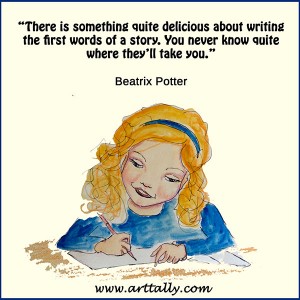 There is something utterly delightful about the idea that you don't have to know exactly where you are going when you start a creative project. The important thing is just to start and trust in the creative process to get you where you need to be. I suppose it is a lesson in surrendering.
There is something utterly delightful about the idea that you don't have to know exactly where you are going when you start a creative project. The important thing is just to start and trust in the creative process to get you where you need to be. I suppose it is a lesson in surrendering.
I'm not sure I realised that you could simply begin a story and let it lead where it may. I did learn that you can paint this way - any one who has had a go at intuitive painting will know exactly what I am talking about.
If you haven't you might want to check out two of my favourite teachers of intuitive painting, Alena Hennessy and Flora Bowley. Even if you don't fancy painting yourself it is a fascinating thing to watch Flora Bowley's paintings emerge - you can see her in action here. And she explains her whole process in her book Brave Intuitive Painting. Love it.
Wouldn't you rather be reclining like a cat on a mat?
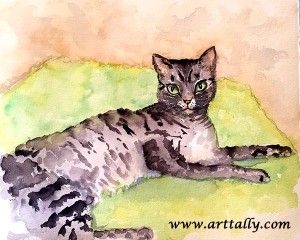 If I am honest, I am getting a little bit tired of painting cats. But I am persisting. What good is a self imposed challenge without a bit of self discipline? It is always quite fun once I get into it, but I am finding that I seem to have a bit of reluctance to face the page at the moment and put another cat on it.
If I am honest, I am getting a little bit tired of painting cats. But I am persisting. What good is a self imposed challenge without a bit of self discipline? It is always quite fun once I get into it, but I am finding that I seem to have a bit of reluctance to face the page at the moment and put another cat on it.
The beginning of a project can be a bit easier. There is a bit of novelty, it's all rather exciting. But once the initial excitement subsides you have to decide whether you have the determination to keep going. If the 'why' behind your project is still clear to you, and still important, that will help you keep going. If you sit around waiting to feel inspired, or to just 'be in the mood', your project's chance of success diminishes drastically.
Creating something new is hard. Don't get me wrong - it's fun too. But when it is hard, you need to remember that the only way to get beyond that beginner stage is to keep going, whether you feel like it or not. Steven Pressfield calls this 'Turning Pro'.
There comes a point in your creative endeavour when you have to make a decision to stop approaching your project as an amateur and treat it as a professional practice. Even on days when you would rather just be reclining like a cat on a mat (as opposed to painting one).
"I write only when inspiration strikes. Fortunately it strikes every morning at nine o'clock sharp." W. Somerset Maugham
How is your happiness project going?
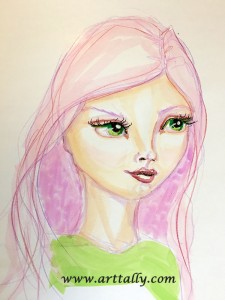 Is happiness one of your priorities? Probably, yes.
Is happiness one of your priorities? Probably, yes.
If you ask most people what they want in life, chances are they will eventually say that they want to be happy. So most of us want happiness, but do we actually do anything to actively seek it?
Gretchen Rubin did. She devoted a year of her life to her happiness project it in fact, and wrote a book about it.
I think it is something we should all consider. Not writing a book about it, necessarily... but what we actually do for ourselves daily in the pursuit of happiness.
Do you know what makes you happy? What do you do for fun?
I suspect far too many of us may have lost sight of the true answers to these questions. Those answers are easily subsumed by expectations we hold of what sensible, appropriate grown ups should do with their leisure time. That of course assumes that we haven't given up on the idea of leisure entirely, in the pursuit of 'success', whatever that may mean to us.
Reading Rubin's account of working through these questions is certainly thought provoking. I have to admit, my initial thoughts included the worrying doubt that devoting a year of a life to one's personal happiness might just be a touch self-indulgent. How telling... I now conclude that it is not at all a selfish luxury. Rather more a responsibility. Each of us brings our energy to the world. Each of us is responsible for choosing what sort of energy that will be.
"Happiness is the meaning and purpose of life, the whole aim and end of human existence." Aristotle
The Happiness Project is not a prescriptive instructional manual. It is more like a diary of Rubin's year long project. It concludes with suggestions on how to start one's own happiness project, recognising that no two projects will be alike. It is up to each one of us to work out what it would take to increase our happiness. If you are wondering where to begin, then I highly recommend this book. Not only for the delightful, personal writing, but for the extensive resource lists at the end of the book.
To my mind, our whole lives are our happiness projects. I wholeheartedly support the idea of setting clear goals of things to add to our lives, or things to change in order to increase our everyday happiness. Analysis, setting objectives and determining measurable action steps to achieve these things - of course I like all that. But I don't see it as the work of a finite period of time. No indeed, that is the work of a lifetime.
Learning to draw different facial expressions
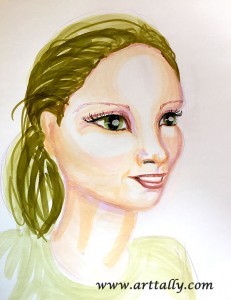 Drawing faces is becoming something of a passion of mine. That is not unusual. Portraits have been a popular subject choice for artists for as long as we have been drawing.
Drawing faces is becoming something of a passion of mine. That is not unusual. Portraits have been a popular subject choice for artists for as long as we have been drawing.
For many of us making art is a way of understanding ourselves and each other. Our faces are what we present to the world. Whether they reveal or conceal our innermost thoughts and feelings, faces can be endlessly fascinating.
Spending time learning to draw different facial expressions and even just different faces is time available to observe and contemplate. That feels like a privilege. I'm sure there is no substitute for a live model, but an ample supply of patient and willing models is not so easy to come by. Not everyone is comfortable with your intense and enduring scrutiny... funny that...
I have learned of a great resource to overcome this particular problem. Mark Simon has developed a series of books that contain photo references - especially made for all types of artists. There are books of adults from 20-83 years of age as well as a book of children from babies to young adults. The books show multiple expressions and angles of each face. Invaluable whether you are learning to draw faces as a beginner, or learning to draw facial expressions, or even if you are a professional needing to draw particular phonemes for animation or graphic novels.
I bought the book with children in it as they are my subject preference. The book is large and feels like a substantial support to my endeavours! At first I was a little disappointed because the cover is in colour and glossy but the interior pages are all in black and white. I soon realised, however, that this is in fact very useful. It is so much easier to see value contrast in a black and white photo. And since I seem determined to give all my subjects green, blue or pink hair, I am hard pressed to think why I would even want to see the photo in colour in the first place.
So, if you are looking for some inspiring faces to draw, check out these books. Yes, I know. There is Pinterest, of course. But for a variety of ages, and expressions over consistent faces, you can't beat a nice sturdy printed book. That's what I think.
A little help starting the creative process
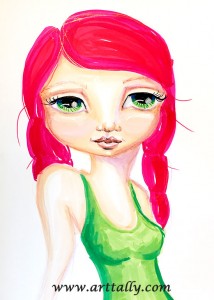 I have learned that you often need a little help starting the creative process. There can be a sort of inertia to overcome. Steven Pressfield calls it Resistance.
I have learned that you often need a little help starting the creative process. There can be a sort of inertia to overcome. Steven Pressfield calls it Resistance.
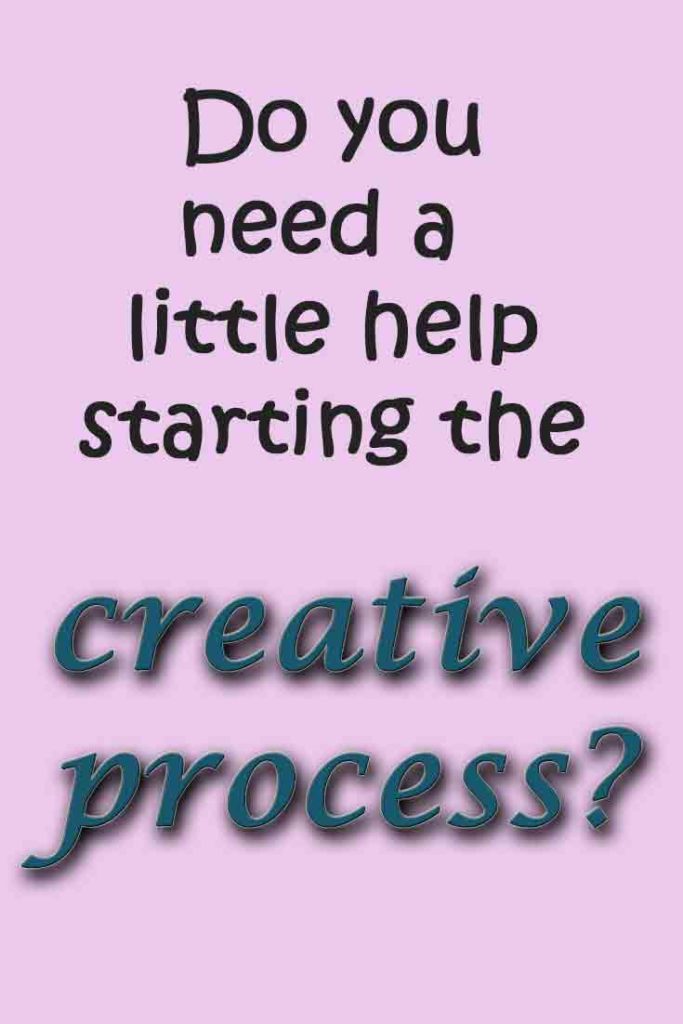 To me it is often just the seemingly insurmountable question of where to begin. Jane advises her students to copy with abandon in the interests of learning - not of course, to pass off these copies as one's own, but to start somewhere. To draw something.
To me it is often just the seemingly insurmountable question of where to begin. Jane advises her students to copy with abandon in the interests of learning - not of course, to pass off these copies as one's own, but to start somewhere. To draw something.
If I am drawing faces, then I can't help but start with Jane Davenport. I am loving her book... this one...
One of the things that troubles me is having all my faces turn out the same. Often quite pretty, but with something of a vacant stare. And once you get used to drawing a particular angle or pose it is very easy to get stuck in a rut.
So today I started out with a face and a bit of a body from the early part of Jane's book. It's quite a surprise how far away you can get from your original inspiration source. This particular page gave me a nice face shape to start with. Braids - I liked those. And a lovely languid pose. But by the time I was done choosing marker colours without thinking too much she turned out with a completely different feeling about her compared to the girl on Jane's page.
What a relief that a little bit of ourselves can't help but ooze out - even when we start from the very same point as somebody else.
Learn to draw faces
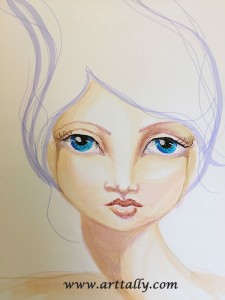 New month - new series! August is going to be all about faces. I have been enjoying drawing teapots but found myself wanting to put faces on them. So I have decided to spend August working on faces.
New month - new series! August is going to be all about faces. I have been enjoying drawing teapots but found myself wanting to put faces on them. So I have decided to spend August working on faces.
One of the first things I learned to draw was faces. Whimsical faces. 'Jane style'. And one of my favourite ways to draw faces is using alcohol markers - something else Jane introduced me too. There is nothing quite like them for making creamy skin tones.
Today I started with Jane's book on drawing beautiful faces. I started, of course, at the section that shows you how to draw a face step by step using markers. This is my version. I am using Spectrum Noir markers. They are the cheaper brand of alcohol markers, but as long as I use proper marker paper, I find that I rather love them. They don't have the brush tip unfortunately, just the chisel but I seem to be okay with that too. After all, significant precision is just not my style!
I highly recommend learning to draw faces. With a few good tips, it is really not as hard as you might think. I started off with Draw Happy, one of Jane's workshops which introduces face drawing. Then I was hooked and did more of her courses that cover faces.
Faces are fascinating. We communicate so much with our faces, even if we don't intend to. So being able to draw a face feels somehow empowering.
Studying faces and expressions to be able to draw them has made me a little more perceptive I think. It certainly makes me really notice someone who is talking to me. I'd like to say that it makes me more present. I think on a good day, it does. But it is also possible that I missed what they were saying because I was trying so hard to observe and remember the tiny expressive crease of brow, a particular dimple that appears only for a certain type of amusement, or the shapes made by shadows falling across the face.
It's all good. It's these tiny details of every little part of our lives that makes them worth living, I think.
Count on a giraffe to brighten your day
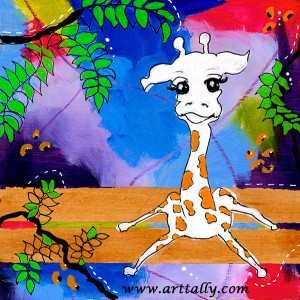 I am painting giraffes this week, and a jolly cheery thing it is to do.
I am painting giraffes this week, and a jolly cheery thing it is to do.
I started out with bright colourful backgrounds I loved .... (and a cup of tea)
And then did some sketches of various giraffes...
and then found that I was quite paralysed when it came to putting the giraffes on the backgrounds. It is hard when you have something you like in the background because you can't help but worry about messing it up. And in a sketch, all is forgiven. Lines that are not quite right seem okay in the sketch, but when you start painting the sketch they start to scream at you.
However, I bravely committed. And I am now resolving to paint more giraffes because they are such a remarkable animal. A most unusual beast. I have learned all sorts of things about them (no fear.... there is more on that in another post...) but today there is something else I want to share.
There is a most wonderful story about a giraffe. It is a children's story... my very favourite kind of story. Like all the best children's stories it has a message for us all. It is a tale about celebrating your uniqueness, forging your own path, knowing you can do anything you put your mind to by finding your own special way.
The book is called Giraffes Can't Dance by Giles Andreae. There are also narrated videos of the picture book available on You Tube. Happily I watched quite a few of them today.... all in the name of research. I think this one is my favourite. Check it out - it's very short, and sure to brighten your day (whatever age you may be).... here is the link.
Get yourself a colouring book....you know you want to
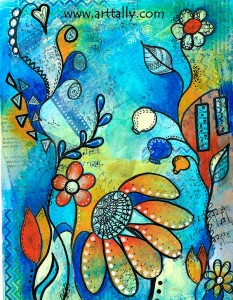 I bet most of the things on your to do list today are useful, important tasks. I bet they are mostly for everyone else. You are planning meals, collecting dry cleaning, meeting your boss’s needs, doing the school run. It’s all good. That’s what we do.
I bet most of the things on your to do list today are useful, important tasks. I bet they are mostly for everyone else. You are planning meals, collecting dry cleaning, meeting your boss’s needs, doing the school run. It’s all good. That’s what we do.
But you need something for you, too. Something just for you, that you do only for fun. Something that doesn’t really matter. Something you are not accountable for. Something you wont be judged on. Something easy, soothing, relaxing. It might even be your secret. But it doesn’t have to be. Like hundreds of chic French women, you might want to get yourself a colouring book.
No, hear me out…. A grown up colouring book. There are more and more of them available. In fact as I write this, the number one bestseller at www.bookdepository.com is Joanna Basford’s Secret Garden. Yes. It’s a colouring book. And guess what number 2 is? Joanna Basford’s orginal colouring book, Enchanted Garden. The top twenty bestselling books at the book depository currently includes no less than 4 adult colouring books.
Think of it as a purposeful activity if you must. A creative kickstart for some, like bestselling author, Joanna Penn. Joanna uses it as a way to get over a creative block and get writing again. It is an easy way to take the pressure off and soothe the muse.
But really, it is therapy. A way to relieve tension and anxiety. It's easier than meditating. Cheaper (and less intrusive) than a counsellor. Sitting down and colouring is pure escapism. It is active meditation. Mindfulness. The world slides by and you hear only the gentle scratch of the pencil tip on the paper. You feel the silky crayon glide satisfyingly over the paper. Glorious colours of your choosing wash the pixels out of your eyes. Who doesn't need a reprieve from those screens?
Remember when you put that first chunky crayon in your toddler’s clumsy fist? We watch our children delight in making marks and relish all that colour. We know it is good for them. That they are playing, learning, growing. As instinctively as they know what to do with the crayon, we know instinctively that we are nurturing them and their creativity. Why do we think we don't need or deserve that anymore?
I would be prepared to bet that you have plenty of juicy art supplies in your house already. You bought them for your children, didn’t you? When you were sitting at that restaurant and whipped out the crayons and paper to entertain your child while your order was prepared, you felt a twinge of longing to join in. A small twinge perhaps… suppressed… but it was there… you know what I am talking about…. You are not the only one - it is exactly how this whole project of mine got started.
So go on - get yourself a colouring book. Raid your kids’ art stash when they are asleep or at school. I can promise it will be fun. You know those scented markers are calling you...
Are artists lonely?
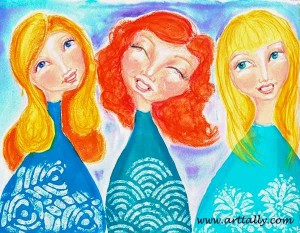 |
| Mixed media journal page created in Jane Davenport's online class 'Frolicaholic' |
I have a Drawing Buddy. We meet once a week and draw and drink lots of tea. (Often more tea than drawing). I am so glad that we do this because I realise how easily I can disappear from the world into art. It has made me wonder whether artists are destined to be rather lonely.
Artists are usually the quiet thinkers. Writing, painting and drawing are solitary pursuits. Most of the time this is good. A chance to escape the noisy rush of life, even if only for a little while.
But does this mean artists are lonely? I think there is a difference between loneliness and solitude. Solitude is a choice.
According to Leo Babauta, solitude is the number 1 habit of highly creative people. He cites both contemporary and historic examples of the artist's need for solitude.
Sarah Lewis also talks about the need for temporarily withdrawing from the world in order to create. Creation comes from our inner private domains. So often we are being told to get our work out where people can see it, being visible and vulnerable. It is easy to forget that there is a need to spend time alone with our thoughts and our art before this can happen. Sarah speaks beautifully about this here, if you have a few minutes to spare.
I have only fairly recently realised how much I need a bit of solitude. But I appreciate in equal measure the chance to meet up with those that share my new found passion for art. I love a Facebook online class group. And I always enjoy my weekly tea and art catch up with Drawing Buddy.
"It is one of the blessings of old friends that you can afford to be stupid with them." Ralph Waldo Emerson
Drawing Buddy and I have each purchased a copy of Carla Sonheim's Drawing Lab for Mixed Media Artists. Each week we pick a Lab to do together. I am finding this book to be a really handy resource. It contains 52 exercises (or labs) which are fairly quick to complete.
- want a warm up activity to get going
- feel stuck and in need of a bit of inspiration
- have a few minutes to spare but are not sure what to draw


